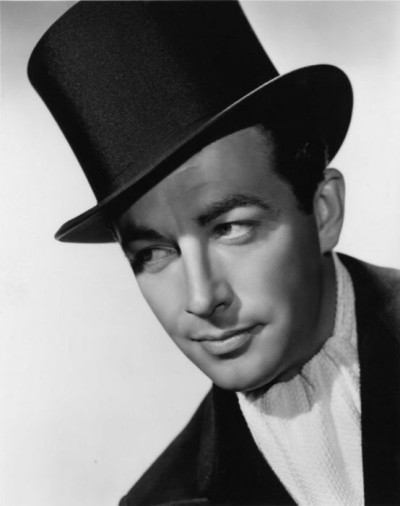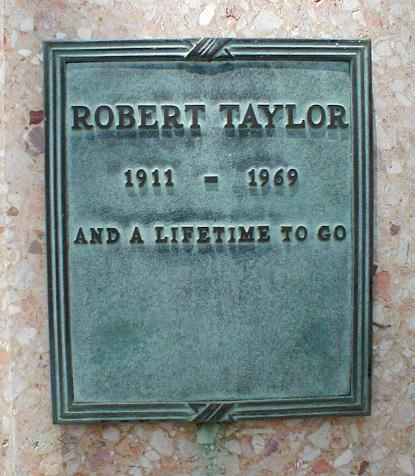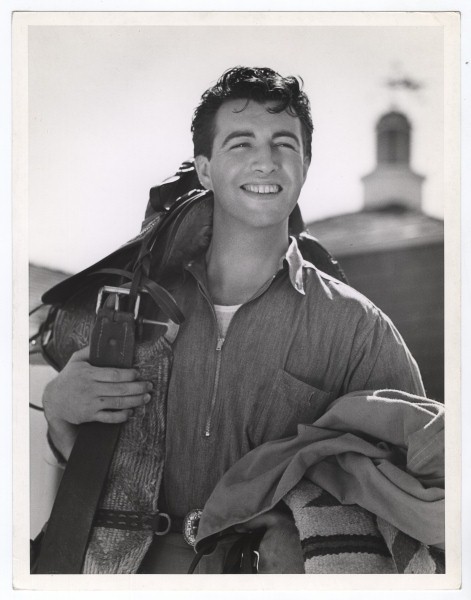Robert Taylor (Spangler Arlington Brugh Taylor)

Born Spangler Arlington Brugh Taylor in Filley, Nebraska, he was the only child of Ruth Adaline (née Stanhope) and Spangler Andrew Brugh, who was a farmer turned doctor. During his early life, the family moved several times, living in Muskogee, Oklahoma; Kirksville, Missouri; and Fremont, Nebraska. By September 1917, the Brughs had moved to Beatrice, Nebraska, where they remained for 16 years. As a teenager, Robert Taylor was a track star and played the cello in his high school orchestra. Upon graduation, he enrolled at Doane College in Crete, Nebraska. While at Doane, he took cello lessons from Professor Herbert E. Gray, a man whom he admired and idolized. After Professor Gray announced he was accepting a new position at Pomona College in Los Angeles, Brugh moved to California and enrolled at Pomona. He joined the campus theater group and was eventually spotted by an MGM talent scout in 1932 after production of Journey’s End. He signed a seven-year contract with Metro-Goldwyn-Mayer with an initial salary of $35 a week, which rose to $2500 by 1936. The studio changed his name to Robert Taylor. He made his film debut in the 1934 comedy, Handy Andy, starring Will Rogers (on a loan-out to 20th Century Fox). His first leading role was in an MGM short subject called Buried Loot. Irene Dunne requested him for her leading man in Magnificent Obsession. This was followed by Camille, opposite Greta Garbo. Throughout the late 1930s, Robert Taylor appeared in films of varying genres including the musicals Broadway Melody of 1936 and Broadway Melody of 1938, and the British comedy A Yank at Oxford with Vivien Leigh. In 1940, he reteamed with Leigh in Mervyn LeRoy’s drama Waterloo Bridge. After being given the nickname “The Man with the Perfect Profile”, Taylor began breaking away from his perfect leading man image and began appearing in darker roles beginning in 1941. That year he portrayed Billy Bonney (better known as Billy the Kid) in Billy the Kid. The next year, he played the title role in the film noir Johnny Eager opposite Lana Turner. After playing a tough sergeant in Bataan in 1943, Taylor contributed to the war effort by becoming a flying instructor in U.S. Naval Air Corps. During this time, he also starred in instructional films and narrated the 1944 documentary The Fighting Lady.
After the war he appeared in a series of edgy roles, including Undercurrent and High Wall. In 1949, he co-starred opposite Elizabeth Taylor in Conspirator. In 1950, Taylor landed the role of General Marcus Vinicius in Quo Vadis, opposite Deborah Kerr. The epic film was a hit, grossing US$11 million in its first run. The following year, he starred opposite Elizabeth Taylor in the film version of Walter Scott’s classic Ivanhoe, followed by 1953’s Knights of the Round Table and The Adventures of Quentin Durward, all filmed in England. Taylor also filmed Valley of the Kings in Egypt in 1954. By the mid-1950s, Taylor began to concentrate on westerns, his preferred genre. He starred in a comedy western in 1955 co-starring Eleanor Parker, Many Rivers to Cross. In 1958, he shared the lead with Richard Widmark in the edgy John Sturges western, The Law and Jake Wade. Also in 1958, he left MGM and formed his own production company, Robert Taylor Productions, and the following year, he starred in the ABC hit television series The Detectives Starring Robert Taylor (1959–1962). Following the end of the series in 1962, Taylor continued to appear in films and television including A House Is Not a Home and two episodes of Hondo. Robert Taylor received the 1953 World Film Favorite – Male, award at the Golden Globes (tied with Alan Ladd). In 1963, NBC filmed, but never aired, four episodes of what was to have been The Robert Taylor Show, a series based on case files from the United States Department of Health, Education and Welfare. The project was suddenly dropped for lack of coordination with HEW. In 1964, Taylor co-starred with his former wife, Barbara Stanwyck, in William Castle’s psychological horror film The Night Walker. In 1965, after filming Johnny Tiger in Florida, Taylor took over the role of narrator in the television series Death Valley Days, when Ronald Reagan left to pursue a career in politics. Robert Taylor would remain with the series until his death in 1969.
In October 1968, Taylor underwent surgery to remove a portion of his right lung after doctors suspected that he had contracted coccidioidomycosis (known as “valley fever”). During the surgery, doctors discovered that he had lung cancer. Taylor, who had smoked three packs of cigarettes a day since he was a boy, quit smoking shortly before undergoing surgery. During the final months of his life, he was hospitalized seven times due to infections and complications related to the disease. He died of lung cancer on June 8, 1969, at Saint John’s Health Center in Santa Monica, California. Robert Taylor’s funeral was held on at Forest Lawn Memorial Park Cemetery, in Glendale, California. Long-time friend Ronald Reagan (who was then the governor of California) eulogized Taylor. Among the mourners were Robert Stack, Van Heflin, Eva Marie Saint, Walter Pidgeon, Keenan Wynn, and Taylor’s ex-wife Barbara Stanwyck. For his contribution to the motion picture industry, Robert Taylor has a star on the Hollywood Walk of Fame at 1500 Vine Street.
Born
- August, 05, 1911
- USA
- Filley, Nebraska
Died
- June, 08, 1969
- USA
- Santa Monica, California
Cause of Death
- lung cancer
Cemetery
- Forest Lawn Memorial Park (Glendale)
- Glendale, California
- USA



